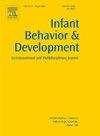Evaluating canonical babbling ratios extracted from day-long audio recordings in infants later diagnosed with autism spectrum disorder
IF 1.9
3区 心理学
Q3 PSYCHOLOGY, DEVELOPMENTAL
引用次数: 0
Abstract
Canonical babbling (CB) is a critical developmental milestone that typically occurs in the second half of the first year of life. Studies focusing on CB in infants at elevated familial likelihood for autism spectrum disorder (ASD) or who later receive an ASD diagnosis are limited and the evidence is mixed. CB comprises a series of canonical syllables (CS) which are defined as the rapid transitions between consonant-like sounds paired with vowel-like sounds (e.g., [gugugu]). One way of measuring CB is by computing canonical babbling ratio (CBR) i.e. total number of CS divided by the total number of syllables. If the child has reached the criterion of 0.15 CBR it is said that they have achieved the CB stage. For several years now, CB has been measured using short lab based or home-based video recordings which may not represent a child’s natural vocalization pattern since child vocalizations fluctuate throughout the day. Day long audio recordings, that capture a child’s vocalizations throughout the day, has the potential to overcome this limitation. Therefore, the current study aimed to answer whether CBRs computed from day-long audio recordings using the language environment analysis (LENA®) were different among infants at elevated familial likelihood for ASD who receive an ASD diagnosis (EL-ASD; n = 11), who did not receive an ASD diagnosis (EL-Neg; n = 32) and infants at low likelihood for ASD (LL-Neg; n = 25) at 9 and 15 months. The study also aimed to evaluate if there are group differences in reaching the canonical babbling stage at 9 and 15 months and are CBRs at 9 and 15 months associated with later language abilities at 24 months. Findings indicated no group differences in mean CBRs at 9 and 15 months and no association with later language abilities. However, we found that children in the EL-ASD group were less likely to reach the 0.15 CBR threshold for being in the canonical babbling stage by 9 months of age. Thus, suggesting that a diagnosis of ASD is associated with delays in CB for some children. Future work in this area must include a larger sample and more standardized annotation protocols to harmonize results across studies and ensure replication.
评估从后来被诊断为自闭症谱系障碍的婴儿的全天录音中提取的典型咿呀学语比率
典型的咿呀学语(CB)是一个关键的发展里程碑,通常发生在生命第一年的下半年。关注自闭症谱系障碍(ASD)家族性可能性升高的婴儿或后来接受ASD诊断的婴儿的CB的研究有限,证据也很复杂。CB由一系列标准音节(CS)组成,这些标准音节被定义为类似辅音的声音与类似元音的声音(例如,[gugugu])之间的快速转换。衡量CB的一种方法是计算规范牙牙学语比(CBR),即牙牙学语总数除以总音节数。如果孩子达到了0.15 CBR的标准,就说他们已经达到了CB阶段。几年来,儿基会一直是通过实验室或家庭录制的短视频来测量的,这些视频可能并不代表孩子的自然发声模式,因为孩子的发声在一天中会波动。全天录音,捕捉孩子一整天的发声,有可能克服这一限制。因此,目前的研究旨在回答使用语言环境分析(LENA®)从全天录音中计算出的cbr是否在接受ASD诊断(EL-ASD;n = 11),未接受ASD诊断(EL-Neg;n = 32)和低可能性ASD婴儿(LL-Neg;N = 25)在9和15个月。该研究还旨在评估在9个月和15个月大时达到标准咿呀学语阶段以及9个月和15个月大时的cbr是否与24个月大时的后期语言能力相关方面是否存在组间差异。研究结果显示,9个月和15个月时的平均cbr没有组间差异,也与后来的语言能力无关。然而,我们发现EL-ASD组的儿童在9个月大的时候不太可能达到0.15 CBR的阈值,进入规范的咿呀学语阶段。因此,这表明ASD的诊断与某些儿童的CB延迟有关。该领域的未来工作必须包括更大的样本和更标准化的注释协议,以协调研究结果并确保复制。
本文章由计算机程序翻译,如有差异,请以英文原文为准。
求助全文
约1分钟内获得全文
求助全文
来源期刊

Infant Behavior & Development
PSYCHOLOGY, DEVELOPMENTAL-
CiteScore
4.10
自引率
4.80%
发文量
94
期刊介绍:
Infant Behavior & Development publishes empirical (fundamental and clinical), theoretical, methodological and review papers. Brief reports dealing with behavioral development during infancy (up to 3 years) will also be considered. Papers of an inter- and multidisciplinary nature, for example neuroscience, non-linear dynamics and modelling approaches, are particularly encouraged. Areas covered by the journal include cognitive development, emotional development, perception, perception-action coupling, motor development and socialisation.
 求助内容:
求助内容: 应助结果提醒方式:
应助结果提醒方式:


